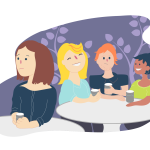Obsessive-Compulsive Disorder (OCD) is a common, chronic, and long-lasting disorder in which a person has uncontrollable, reoccurring thoughts (obsessions) and behaviors (compulsions) that he or she feels the urge to repeat over and over. This disorder often manifests in ways that can significantly interfere with an individual’s daily activities and social interactions. This article explores OCD’s nature, impact, risk factors, and treatment options.
Definition:
- Obsessive-Compulsive Disorder (OCD) involves a pattern of unwanted thoughts and fears (obsessions) that lead you to do repetitive behaviors (compulsions).
Prevalence:
- OCD affects about 2-3% of people in the United States during their lifetime.
- It can begin in childhood, adolescence, or adulthood, with most cases diagnosed by age 19.
- The disorder is typically a lifelong challenge, although the intensity of symptoms can fluctuate over time.
- Both men and women are equally likely to be diagnosed with OCD.
Risk Factors:
- Genetics: A family history of OCD significantly increases the risk, especially if a first-degree relative developed the disorder at an early age.
- Brain Structure and Functioning: Some evidence suggests that differences in the brain may contribute to the onset of OCD.
- Behavioral Factors: People who have tendencies towards neatness, perfectionism, and control are more likely to develop OCD.
- Stressful Life Events: Significant life stressors or traumatic events can trigger OCD or make it worse.
- Existing Mental Health Conditions: Conditions such as anxiety disorders, depression, or tic disorders often co-occur with OCD.
Signs and Symptoms:
- Obsessions: These are repeated thoughts, urges, or mental images that cause anxiety. Common themes include fear of germs, need to have things in a particular order, aggressive or horrific thoughts.
- Compulsions: Repetitive behaviors that a person with OCD feels the urge to do in response to an obsessive thought. Common compulsions include excessive cleaning, ordering, checking, and repeatedly performing the same actions.
- Severe Anxiety: OCD symptoms are accompanied by intense distress and a severe impact on daily functioning.
- Recognition of Excessiveness: Most adults with OCD are aware that their obsessions and compulsions are irrational, but this recognition can be less clear in children.
Treatment:
- Cognitive Behavioral Therapy (CBT): Specifically, Exposure and Response Prevention (ERP) is considered the most effective type of CBT for treating OCD.
- Medication: Antidepressants are commonly used to help control obsessions and compulsions.
- Deep Brain Stimulation (DBS) and Other Neurological Treatments: For severe cases not responding to traditional methods, these advanced therapies may be considered.
- Support Groups: Connecting with others facing similar challenges can provide emotional support and coping strategies.
- Holistic Approaches: Mindfulness and relaxation techniques can also help manage anxiety and stress related to OCD.
Conclusion: OCD is a complex disorder that goes beyond everyday worries or habits. It is a serious mental health condition that requires understanding, compassion, and comprehensive treatment strategies. With appropriate care, individuals with OCD can gain significant relief from their symptoms and lead productive, fulfilling lives.
For more insights and resources on managing OCD, consider visiting:




